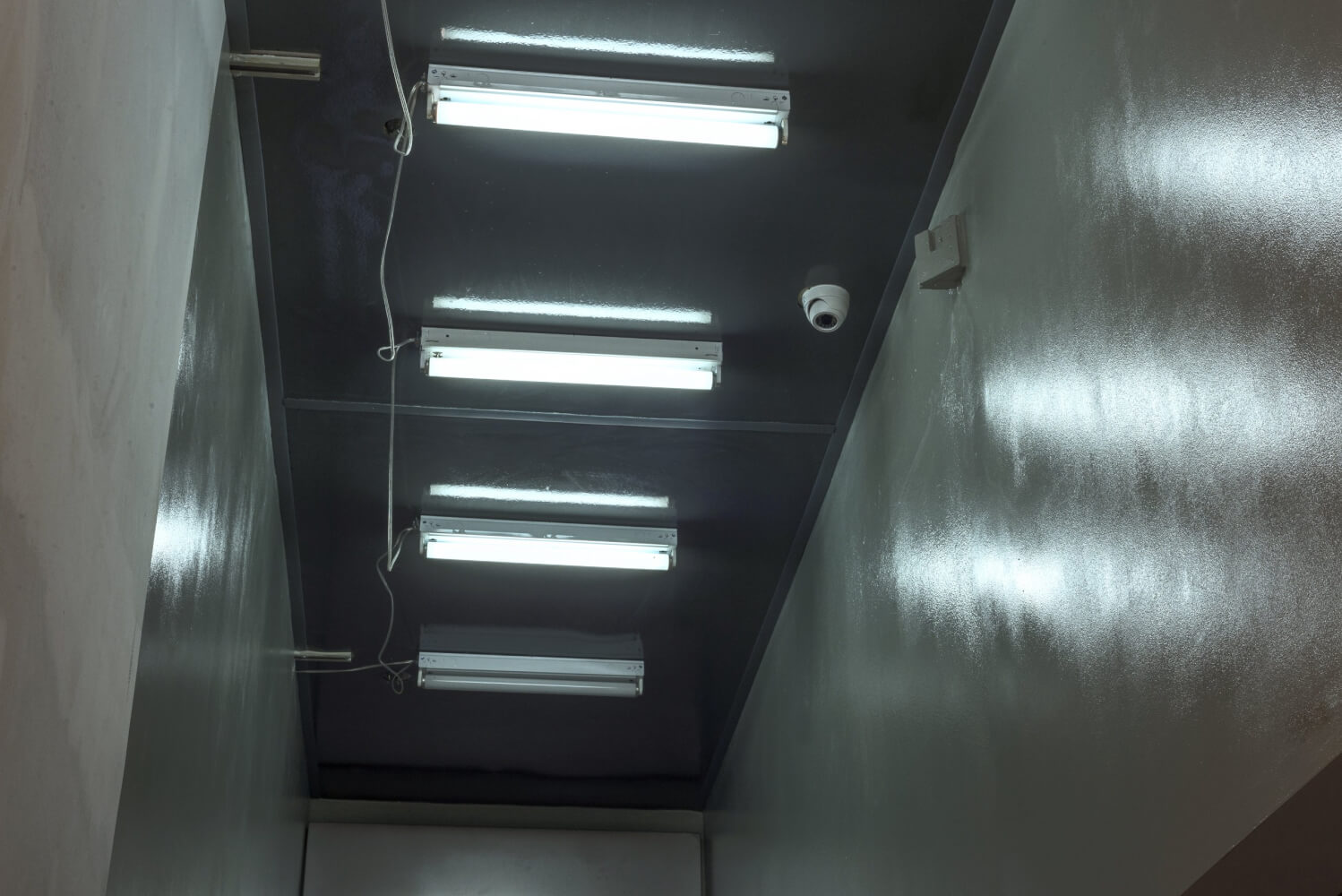
Benedick, or Else
THIS IS Alessandro Bava in conversation with Dora Budor
The work of Croatian artist Dora Budor is increasingly shifting in territory — oscillating between an interest in film, narrative and her (distant) background in architecture. Her latest exhibition at 80WSE, New York, evolved from an engagement with the rich substratum of a building’s history and reflects on the multiple transformations that shape its character. Intervening into the morphology of rooms inside the Benedick building, Budor builds on her fascination with the way prosthetic and functional qualities of space impact our lived experience. ‘Benedick, or Else’ is a play without the actors, a scripted spatial experience that explodes the exhibition format into a semi-scripted scenario.
THIS IS BADLAND: This biography of the building reflects a nonlinear chronology. I’m interested to know more about the process of your research into its history.
DORA BUDOR: The gallery is situated in a building nick-named The Benedick, which was built in 1879 on 80 Washington Square East, and in 1925 was bought by the New York University. It was commissioned by iron merchant Lucius Tuckerman, who was also Vice President of the Metropolitan Museum of Art, to be the first ‘bachelor building’ in the city that would provide affordable live/work lodgings to single men — most of whom were painters, sculptors, writers and architects.
It was the cradle of bohemia in the Gilded Age of New York that was challenging the routines of the staid and the conventional, and it also hosted something called The Sewer Club. The building got its nickname after a bachelor character in Shakespeare’s play ‘Much Ado About Nothing,’ and the link to theatre extended wider. That era was characterised by the collapse of public (theater) into the private sphere, being the first time when performances and theatrical enactments would enter private homes and artists studios as a form of entertainment and socialising.
The space itself had an existing character that was very prominent. It bore marks of its past from the ways it was built, repurposed and remodeled repetitiously, which was quite removed from the usual white cube. That lead me to work with a researcher and dig through lots of historical documents and look at some fascinating photographic documentation from its past. The whole process was circular in a narrative way, where the things I would find informed the relationship to the current situation. After some time, I understood I was looking for patterns: behavioural, social and economic nodes on a narrative arc.
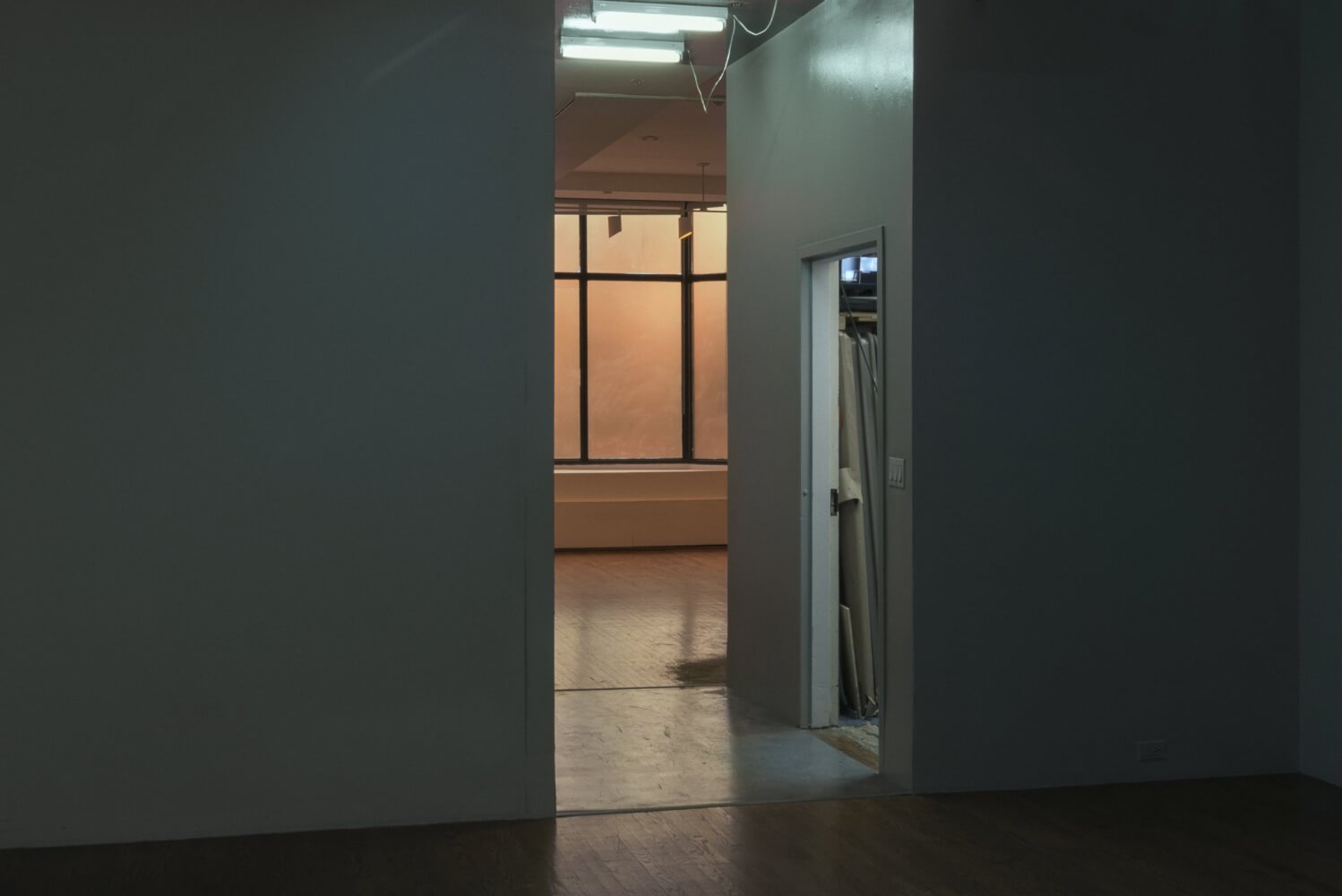
TIB: Something urbanists have lost the ability to do, perhaps being too complacent with the systems at play or just because the lenses to read the contemporary city are outdated. I'm interested in learning more about the building and urban scenario of NYU, and how you used it as material for the exhibition script.
DB: Well, after 1925, the Benedick building was taken over as part of the University expansion around the Square, which started to completely redesign the urban fabric. As one of the wealthiest private universities, NYU has a history of razing down low-income housing or displacing current tenants. It has undergone several large projects of expansion, the second one being University Village in the 60s. Built as part of a slum-clearing project planned by urban planner Robert Moses as part of the Housing Act of 1949, the plan created three ‘superblocks’ of faculty and graduate student housing, while displacing those who lived in the now-razed tenements. Now, there is an active plan under the name NYU 2031 Expansion Plan, guided by the board, whose members are all real estate developers. The plan features taking over 2 million square feet of land in the Greenwich Village over the next decade. On the official website of the 2031 plan, highlighted in a purple sidebar, former mayor Michael Bloomberg pontificates the longstanding symbiosis of New York and the University, starting with:
“It’s very hard to differentiate where New York University stops and New York City starts...”
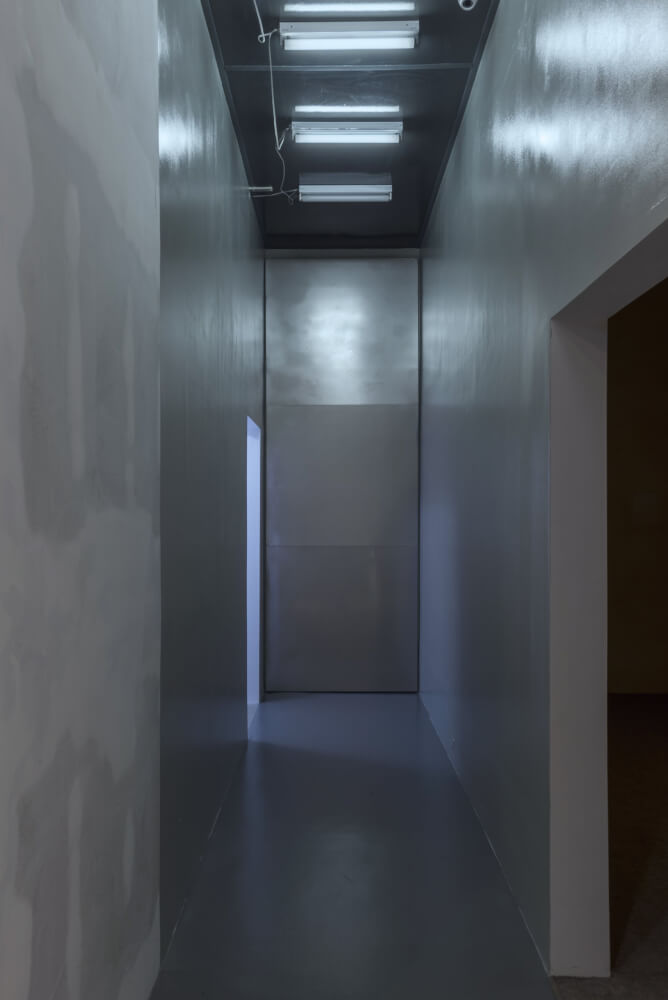
TIB: Could you tell me more about the process of working with a professional set designer/scenographer in terms of the idea to blur historical facts and fiction?
DB: I wanted to transform the experience of walking through space and into a narrative — a play, in which the architecture has the lead role. So I collaborated with a scenographer, Andromache Chalfant, who helped to bring in elements of the stage that were used to affect and script the visitor’s experience of the space. We worked with the architectural plan that hosted devices like parallel plot and ellipsis, where parts are omitted, temporalities blur into each other, or things reappear and multiply. You can notice that in the elements of building: doubles of side rooms, intensifying and bringing back certain architectural features, creating sequences of repeating hallways, and fabricating different light conditions in the rooms. We also used some scenic painting, props and architectural additions to bring back certain socionatures and behaviours that the building hosted throughout its life — referring to the idea of post-occupancy.
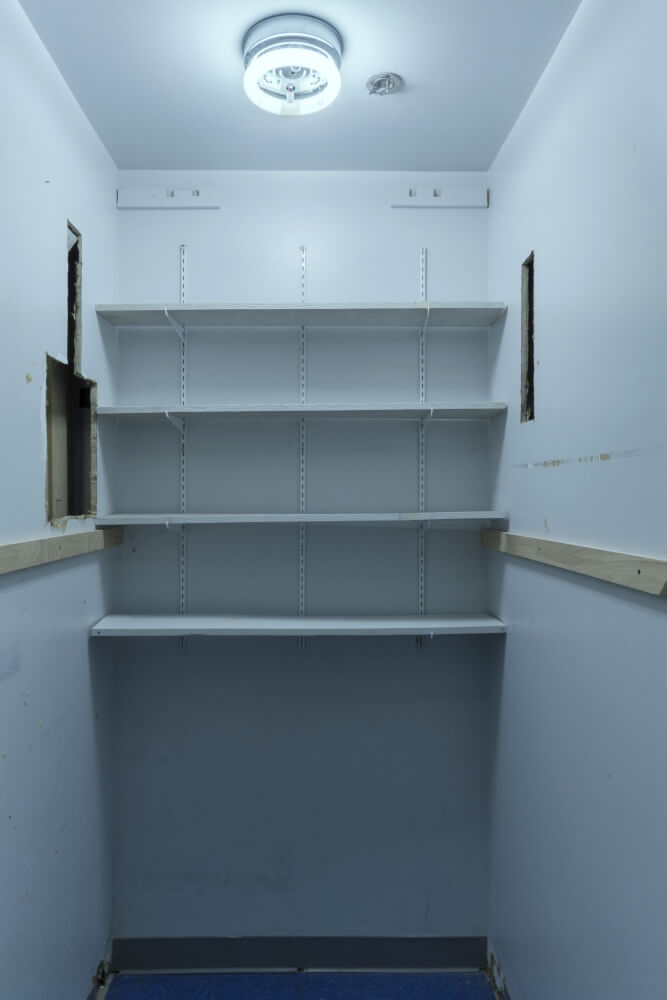
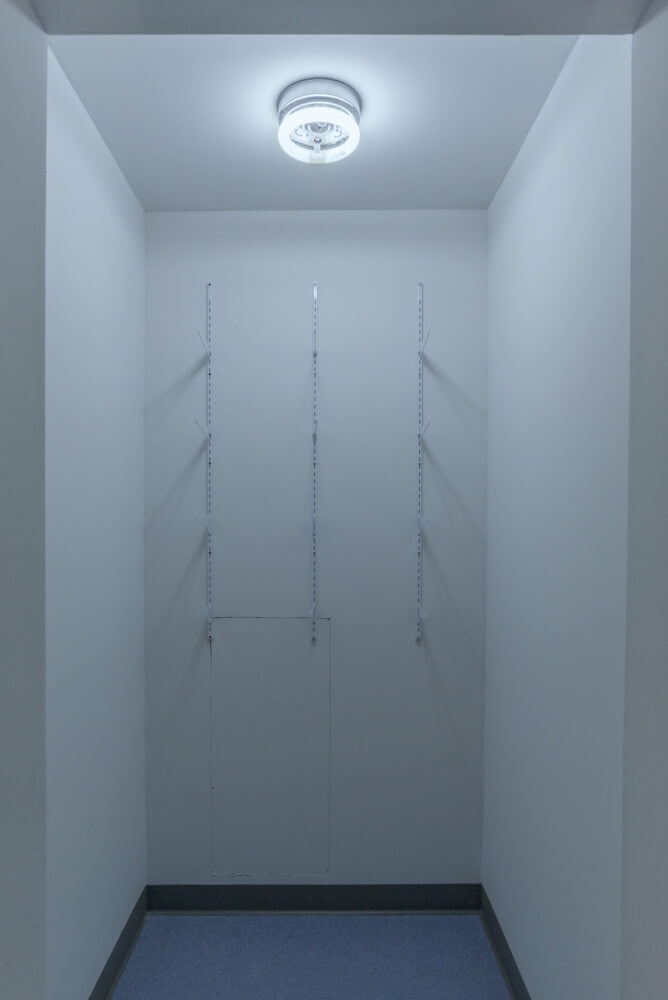
Also, I felt that the collaboration with a scenographer allowed me to seamlessly blur the fictional elements with the real. These elements be- came the ‘past mode’ of the narrative. The script functions as a projection — it describes the narrative that you don’t see, but imagine, as you walk around. It talks about the planned expansion and development of the metropolis, but also construction of the organisational complex, ‘ideology of the cancer cell’ — growth for the sake of growth, and the sociochemical relationship between architecture and its inhabitants.
TIB: In NYC, the art scene also mobilised an architect’s gaze in a critical and political way. But, looking at the wider historical context, you find mostly male artists engaging with the public space. In a recent interview, Martha Rosler said that in the 70s, working with space was seen as “a male preoccupation,” an assumption she sought to disrupt.
DB: It is very interesting you mention this, which is definitely true. One of the reasons why I was interested in the bachelors as the first bohemian inhabitants of the building, was the contradiction of affordable and open-minded environment that allowed for communality, intimacy and arts to flourish, and all types of freedoms to be expressed. But, at the end of the day, that was only accessible to white men. I felt necessary for that history to become part of the show and for its ‘ghost’ to inhabit the environments. On the other side, there is the recent history of the space. Nicola Lees has been the director of the space for the last two years, and the programming of the gallery has a strong accent on female artists practices. My exhibition came after Louise Lawler’s show, which was only viewable at night, and Lutz Bacher’s, who rendered the experience of the oppressive, surveilled environment through repetitive display devices throughout the rooms. Both of them responded to the space, and integrated the specificity of the environment into their exhibitions, and when I came in I felt compelled to do the same. These are, however, I think, much different sets of concerns and tactics than the ones historically related to artists engaging with the space — they take it as an inherent part of the vocabulary while dealing with the problem of the exhibition, instead of presenting it as novum.
You spoke about the historical precedent of primarily male artists engaging with the space and architectural thought in the 70s, and female artists trying to disrupt it, as in Rosler’s case, with shifting of the focus to issues of female labor, domesticity, inequality — all to create an ecology of relationships in and around of architecture. At its core, they question architecture’s nature as a singular, formalised and fixed object. Recently, Hilary Sample termed the expression ‘maintenance architecture’ to introduce the idea in architectural theory of human relationships beyond the technical, and provide a view in which the evidence of lived-in time and post-occupancy cannot longer be detached from the architectural practice.
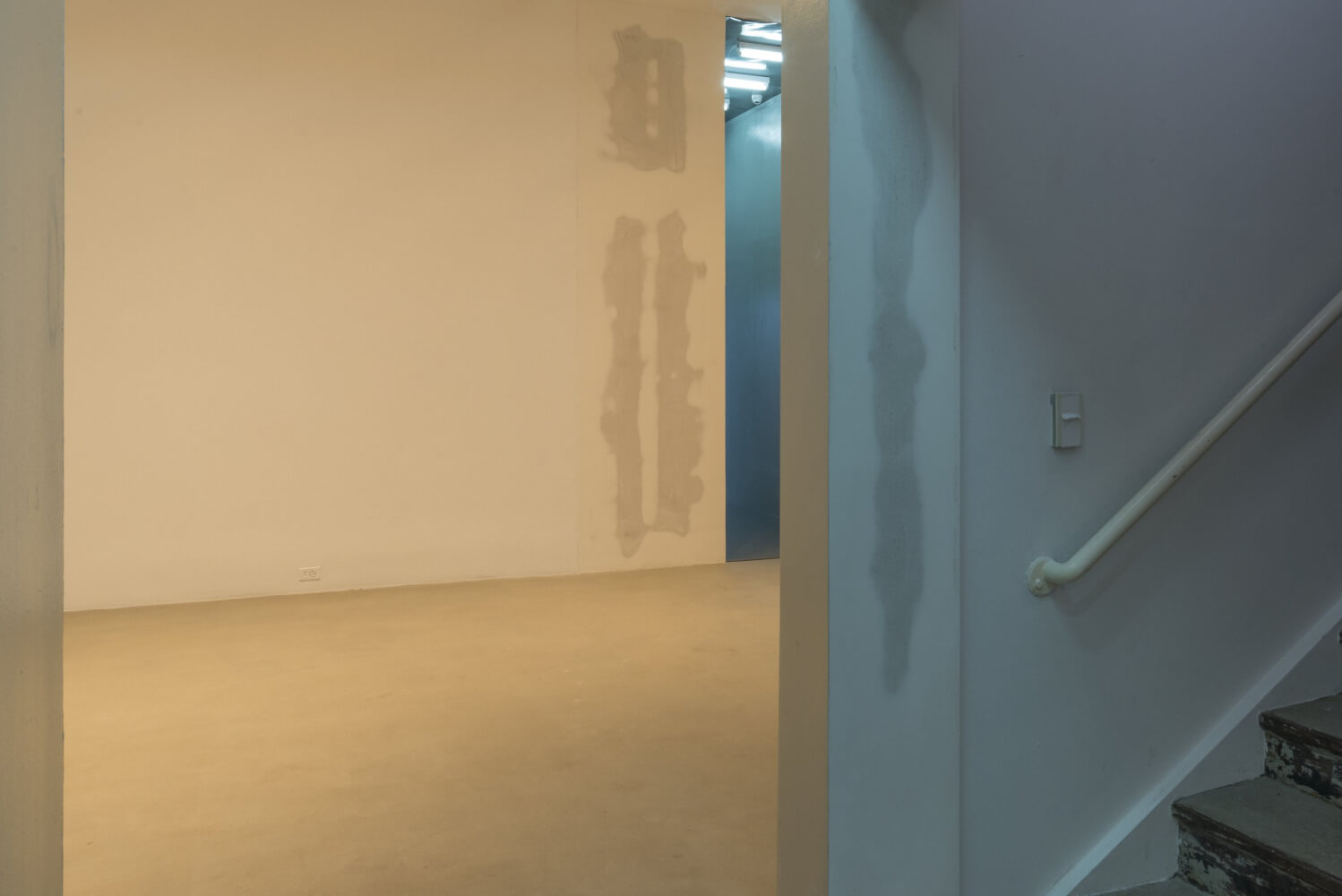
TIB: I was wondering if you’ve come across Rem Koolhaas’ Delirious New York in your research, and if you’d say that you’ve employed a similar ‘paranoid-critical’ method in your analysis of the context for the exhibition. Simultaneously, I know you have read and been inspired by Junkspace — I would love to know more specifically what attracted you to Junkspace.
DB: I read Junkspace for the first time when I was visiting Shanghai, which subtitled my whole experience there: endlessly cruising through reflective surfaces, air-conditioned malls, and endless blur of cityscape on the horizon. Coming back to New York, I saw the city in an enhanced way, where I couldn’t stop relating it to Shanghai, as its future, but also its mirror. “There is a special way of moving in the Junkspace, at the same time aimless and purposeful,” I wanted the exhibition to feel like that in a way. Also, I thought a lot of Archizoom’s No-Stop City, which is a predecessor to Koolhaas’ Junkspace. For Archizoom, No-Stop City performed a scientific analysis of the contemporary urban condition, simultaneously utopian and dystopian — employing the abstract, theoretical, and conjectural tools of architectural representation. Both Andrea Branzi [of Archizoom] and Koolhaas take from Hilberseimer to conceive of the ‘city without qualities,’ in which the city no longer represents the system, but becomes the system itself — programmatic, isotropic, self-contained with all of its contradictions, where there is no outside. So in order to create this catatonic environment, a play of mirrors, one of the ideas was that there is no centre and there is no focus, only progress. Those were some of the things we embedded in architectural changes in the space that I mentioned before. The script served to both abstract the future and provide the projection of what the space would be without having to be physically descriptive, it also acts as a double-edged sword: guiding you through the space and raising your expectations, but also keeping you at a distance, somewhat unattainable, disappointing even.
Photos: Dora Budor, Benedick, or Else, 2018. Environment: scenographic elements, script, architectural modifications, light. Dimensions variable
Exhibited at 80WSE, New York
December 15, 2018 – February 16, 2019
curated by Nicola Lees

Benedick, or Else
THIS IS Alessandro Bava in conversation with Dora Budor
The work of Croatian artist Dora Budor is increasingly shifting in territory — oscillating between an interest in film, narrative and her (distant) background in architecture. Her latest exhibition at 80WSE, New York, evolved from an engagement with the rich substratum of a building’s history and reflects on the multiple transformations that shape its character. Intervening into the morphology of rooms inside the Benedick building, Budor builds on her fascination with the way prosthetic and functional qualities of space impact our lived experience. ‘Benedick, or Else’ is a play without the actors, a scripted spatial experience that explodes the exhibition format into a semi-scripted scenario.
THIS IS BADLAND: This biography of the building reflects a nonlinear chronology. I’m interested to know more about the process of your research into its history.
DORA BUDOR: The gallery is situated in a building nick-named The Benedick, which was built in 1879 on 80 Washington Square East, and in 1925 was bought by the New York University. It was commissioned by iron merchant Lucius Tuckerman, who was also Vice President of the Metropolitan Museum of Art, to be the first ‘bachelor building’ in the city that would provide affordable live/work lodgings to single men — most of whom were painters, sculptors, writers and architects.
It was the cradle of bohemia in the Gilded Age of New York that was challenging the routines of the staid and the conventional, and it also hosted something called The Sewer Club. The building got its nickname after a bachelor character in Shakespeare’s play ‘Much Ado About Nothing,’ and the link to theatre extended wider. That era was characterised by the collapse of public (theater) into the private sphere, being the first time when performances and theatrical enactments would enter private homes and artists studios as a form of entertainment and socialising.
The space itself had an existing character that was very prominent. It bore marks of its past from the ways it was built, repurposed and remodeled repetitiously, which was quite removed from the usual white cube. That lead me to work with a researcher and dig through lots of historical documents and look at some fascinating photographic documentation from its past. The whole process was circular in a narrative way, where the things I would find informed the relationship to the current situation. After some time, I understood I was looking for patterns: behavioural, social and economic nodes on a narrative arc.

TIB: Something urbanists have lost the ability to do, perhaps being too complacent with the systems at play or just because the lenses to read the contemporary city are outdated. I'm interested in learning more about the building and urban scenario of NYU, and how you used it as material for the exhibition script.
DB: Well, after 1925, the Benedick building was taken over as part of the University expansion around the Square, which started to completely redesign the urban fabric. As one of the wealthiest private universities, NYU has a history of razing down low-income housing or displacing current tenants. It has undergone several large projects of expansion, the second one being University Village in the 60s. Built as part of a slum-clearing project planned by urban planner Robert Moses as part of the Housing Act of 1949, the plan created three ‘superblocks’ of faculty and graduate student housing, while displacing those who lived in the now-razed tenements. Now, there is an active plan under the name NYU 2031 Expansion Plan, guided by the board, whose members are all real estate developers. The plan features taking over 2 million square feet of land in the Greenwich Village over the next decade. On the official website of the 2031 plan, highlighted in a purple sidebar, former mayor Michael Bloomberg pontificates the longstanding symbiosis of New York and the University, starting with:
“It’s very hard to differentiate where New York University stops and New York City starts...”

TIB: Could you tell me more about the process of working with a professional set designer/scenographer in terms of the idea to blur historical facts and fiction?
DB: I wanted to transform the experience of walking through space and into a narrative — a play, in which the architecture has the lead role. So I collaborated with a scenographer, Andromache Chalfant, who helped to bring in elements of the stage that were used to affect and script the visitor’s experience of the space. We worked with the architectural plan that hosted devices like parallel plot and ellipsis, where parts are omitted, temporalities blur into each other, or things reappear and multiply. You can notice that in the elements of building: doubles of side rooms, intensifying and bringing back certain architectural features, creating sequences of repeating hallways, and fabricating different light conditions in the rooms. We also used some scenic painting, props and architectural additions to bring back certain socionatures and behaviours that the building hosted throughout its life — referring to the idea of post-occupancy.


Also, I felt that the collaboration with a scenographer allowed me to seamlessly blur the fictional elements with the real. These elements be- came the ‘past mode’ of the narrative. The script functions as a projection — it describes the narrative that you don’t see, but imagine, as you walk around. It talks about the planned expansion and development of the metropolis, but also construction of the organisational complex, ‘ideology of the cancer cell’ — growth for the sake of growth, and the sociochemical relationship between architecture and its inhabitants.
TIB: In NYC, the art scene also mobilised an architect’s gaze in a critical and political way. But, looking at the wider historical context, you find mostly male artists engaging with the public space. In a recent interview, Martha Rosler said that in the 70s, working with space was seen as “a male preoccupation,” an assumption she sought to disrupt.
DB: It is very interesting you mention this, which is definitely true. One of the reasons why I was interested in the bachelors as the first bohemian inhabitants of the building, was the contradiction of affordable and open-minded environment that allowed for communality, intimacy and arts to flourish, and all types of freedoms to be expressed. But, at the end of the day, that was only accessible to white men. I felt necessary for that history to become part of the show and for its ‘ghost’ to inhabit the environments. On the other side, there is the recent history of the space. Nicola Lees has been the director of the space for the last two years, and the programming of the gallery has a strong accent on female artists practices. My exhibition came after Louise Lawler’s show, which was only viewable at night, and Lutz Bacher’s, who rendered the experience of the oppressive, surveilled environment through repetitive display devices throughout the rooms. Both of them responded to the space, and integrated the specificity of the environment into their exhibitions, and when I came in I felt compelled to do the same. These are, however, I think, much different sets of concerns and tactics than the ones historically related to artists engaging with the space — they take it as an inherent part of the vocabulary while dealing with the problem of the exhibition, instead of presenting it as novum.
You spoke about the historical precedent of primarily male artists engaging with the space and architectural thought in the 70s, and female artists trying to disrupt it, as in Rosler’s case, with shifting of the focus to issues of female labor, domesticity, inequality — all to create an ecology of relationships in and around of architecture. At its core, they question architecture’s nature as a singular, formalised and fixed object. Recently, Hilary Sample termed the expression ‘maintenance architecture’ to introduce the idea in architectural theory of human relationships beyond the technical, and provide a view in which the evidence of lived-in time and post-occupancy cannot longer be detached from the architectural practice.

TIB: I was wondering if you’ve come across Rem Koolhaas’ Delirious New York in your research, and if you’d say that you’ve employed a similar ‘paranoid-critical’ method in your analysis of the context for the exhibition. Simultaneously, I know you have read and been inspired by Junkspace — I would love to know more specifically what attracted you to Junkspace.
DB: I read Junkspace for the first time when I was visiting Shanghai, which subtitled my whole experience there: endlessly cruising through reflective surfaces, air-conditioned malls, and endless blur of cityscape on the horizon. Coming back to New York, I saw the city in an enhanced way, where I couldn’t stop relating it to Shanghai, as its future, but also its mirror. “There is a special way of moving in the Junkspace, at the same time aimless and purposeful,” I wanted the exhibition to feel like that in a way. Also, I thought a lot of Archizoom’s No-Stop City, which is a predecessor to Koolhaas’ Junkspace. For Archizoom, No-Stop City performed a scientific analysis of the contemporary urban condition, simultaneously utopian and dystopian — employing the abstract, theoretical, and conjectural tools of architectural representation. Both Andrea Branzi [of Archizoom] and Koolhaas take from Hilberseimer to conceive of the ‘city without qualities,’ in which the city no longer represents the system, but becomes the system itself — programmatic, isotropic, self-contained with all of its contradictions, where there is no outside. So in order to create this catatonic environment, a play of mirrors, one of the ideas was that there is no centre and there is no focus, only progress. Those were some of the things we embedded in architectural changes in the space that I mentioned before. The script served to both abstract the future and provide the projection of what the space would be without having to be physically descriptive, it also acts as a double-edged sword: guiding you through the space and raising your expectations, but also keeping you at a distance, somewhat unattainable, disappointing even.
Photos: Dora Budor, Benedick, or Else, 2018. Environment: scenographic elements, script, architectural modifications, light. Dimensions variable
Exhibited at 80WSE, New York
December 15, 2018 – February 16, 2019
curated by Nicola Lees

